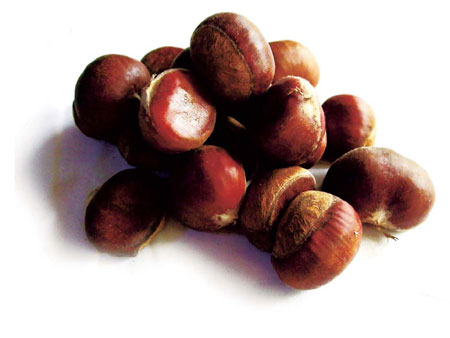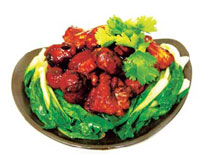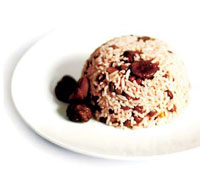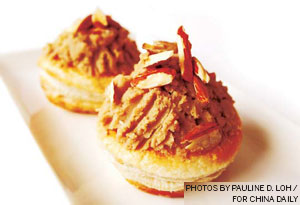Chestnuts of the season

Smoky sugar-roasted chestnuts warm up the cold months like few other foods. Pauline D. Loh shares some savory and sweet ways to cook with the harvest.
Deep within the Ming Tomb courtyards way out in the suburbs of Beijing, there are huge spreading chestnut trees standing sentinel outside the entrances. Underneath, stone tables and benches provide resting places for tired travelers or visitors simply overwhelmed by the evidence of so much history before them.
In season, the ground under the trees is littered with prickly burred fruits, many of which have split to reveal the brown nuts inside.
That would signal autumn and the beginning of the frosty chill that blankets Beijing almost a third of the year. That's also when traditional shops in the Forbidden City crank up their roasting bins, all ready to cater for the queues that form outside the shops for the first taste of sugar-roasted chestnuts.
The Chinese chestnut, a hardy species, grows from as far north as Dandong, Liaoning province, at the border of the Democratic People's Republic of Korea, to the wetter, warmer climes of Sichuan and Guangdong provinces. While the north prefers roasting its chestnuts as a winter snack, the cooks in the southern parts have incorporated this tasty nut into dishes for the dining table all year round, using dried chestnuts when fresh is not available.
In my family, when fresh chestnuts appear on the market, my grandmother would prepare one of her better-appreciated dishes - a braised chicken with whole chestnuts, garlic cloves and tiny red shallots. Even my normally demanding grandfather would relax and give her grudging praise, a departure from his usual fastidiousness. Me, I would be too busy eating.
Later on, as I traveled, I would come across unusual chestnut dishes. The beautifully crafted and sculpted chestnuts in Kyoto are made into candies or preserved in adzuki bean jelly. True to the Japanese tradition of total symmetry in food preparation, nimble chefs carve the chestnuts into perfect shapes before settling them into a thick red bean paste or konnyaku jelly.
Chestnuts were also candied, much like Beijing's bingtang hulu or candied haw. The Japanese also mix chestnuts into their rice, the nuts perfuming the cereal with the subtlest fragrance.
I have also eaten chestnut rice in the Republic of Korea, where they add red beans to the mix. As a result, the rice is both pretty and flavorful.
When I went to school in the United States, we had chestnut trees on campus. They were American chestnuts. No one seemed to pay the fallen nuts any attention at all, and they were trodden underfoot and squashed by passing traffic. To see such lovely nuts so carelessly treated pained me and finally, I gathered some of the Asian students and we went chestnut collecting after classes.
There was such bounty that we went home with fully 10 kg or more of nuts. We had a pig-out that included roasted chestnuts on the barbecue, boiled chestnuts, my gran's Chinese chestnut chicken and finally, a chestnut gateau that we assembled with some ready-made puff pastry and the boiled chestnuts which we pureed with maple syrup and double cream.
It was a delicious feast. We still had more nuts left over, and we roasted them, pulverized the nuts into a damp meal which we mixed with milk and then baked till set. The "cake" was chilled, cut into squares and re-fried in butter like polenta. I later learned that we did nothing original and that in certain parts of Italy, chestnut "polenta" was common country food.
By the way, here are some chestnut cooking tips.
When roasting or boiling chestnuts, snip the softer pointed end so the steam that builds up inside the shell can be released. Otherwise you may get exploding chestnuts. Once you peel off the hard outer shell, the next step is to get rid of the furry brown skin. The secret is to peel it when it is still hot. Once it is cold, the papery skin sticks like a glove.
Chestnut is very starchy and you must not overcook the nuts or they will simply disintegrate. Done well, this tasty nut will reward you with the flavor of autumn.

Recipe
| Chinese Chicken With ChestnutsIngredients (serves 4):
2 whole chicken legs, cut into bite-sized chunks
300 g chestnuts, boiled and skinned
6-8 cloves garlic, peeled
10 shallots, peeled
1 tbsp sugar
2-3 slices of ginger
4 tbsp oyster sauce
Pepper to taste
Method:
1. Heat up some vegetable
oil in a non-stick frying pan.
2. Add the peeled whole garlic cloves, peeled whole shallots and brown all over. Add ginger slices and brown till fragrant.
3. Add chicken pieces and the sugar, turn up the heat and sear on all sides until lightly caramelized. Add the chestnuts.
4. Pour away any excess oil and return to heat. Add the oyster sauce and pepper to taste and half a cup of water.
5. Reduce to a simmer and cook until most of the water has evaporated and the sauces have thickened to coat the ingredients evenly.
6. Garnish with coriander or spring onions, and serve piping hot.

Recipe
| Red Bean Rice With ChestnutsIngredients (serves 4):
2 cups jasmine or basmati rice, soaked an hour ahead
1 cup red beans, soaked overnight
200 g fresh peeled chestnuts (or 100 g dried chestnuts, soaked overnight)
3 cups vegetable stock or water
1 tsp yeast extract (Marmite, Vegemite) - optional
Method:
1. Place all ingredients into an automatic rice cooker. Stir to dissolve the yeast extract and switch on to cook.
2. Alternatively, place all ingredients in a large pot, bring to a boil and quickly turn down to a simmer until liquid is fully absorbed and all the grains are tender.
3. Serve hot.

Recipe
| Chestnut PuffsIngredients (serves 4):
1 sheet ready-made puff pastry, cut into 8 rounds
300 g boiled chestnuts
4 tbsp maple syrup or honey
100 ml thick cream
1 egg, beaten
A few roasted unsalted almonds, cut into slivers
Method:
1. Place four of the pastry rounds on a papered baking tray. Cut out the centers of the remaining rounds, so you get a 1 cm thick ring of pastry.
2. Brush the edges of the pastry round on the tray and place the rings on top. Use a fork to press the edges down, and brush the top of the rings with beaten egg.
3. Bake in a hot oven of about 220 C until pastry is well-risen and puffed. Cool.
4. Puree the boiled chestnuts with a blender, adding the honey and cream as you go so you get a thick paste.
5. When the pastry is fully cooled, mount the chestnut puree on top of the puff pastry and garnish with slivered almonds.
6. Serve at once as the pastry tends to soften. Simple but lovely to look at and delicious.
(China Daily 11/27/2010 page12)














